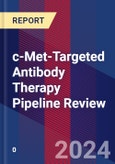This product provides basic information on antibody therapy candidates in research and development targeting c-Met.
This product consists of:
- Competitors described in a tabular format covering drug code/INN, target(s)/MoA, class of compound, product category, indication(s) & R&D stage.
- Project History with links to source of information (press release, homepage, abstracts, presentations, annual reports etc).
- One-month online access to a database for therapeutics and therapy candidates targeting c-Met (prerequisite: access to internet).
This product is delivered on the very same day of purchase by e-mail containing competitor and project history reports in pdf format and database credentials. Reports are prepared on the same day.
The c-MET signalling pathway consists of the mesenchymal epithelial transition factor (c-MET) transmembrane receptor tyrosine kinase receptor (RTK) and its ligand hepatocyte growth factor (HGF) or scatter factor (SF). Binding of HGF/SF to c-MET activates downstream signalling pathways such as Rho, focal adhesion kinase (FAK) and PI3K. These pathways regulate cancer cell growth, survival angiogenesis, invasion and metastasis. Thus, prevention of c-MET dependent neoplastic processes may provide a means for managing invasive tumors of high metastatic potential. c-Met is a well-characterized oncogene that is associated with poor prognosis in many solid tumor types.
In fact, c-MET/HGF has evolved as an attractive target for the pharmaceutical industry. Several c-Met RTK inhibitors have made it to the market to treat non-small cell lung cancer with specific MET mutations - Novartis’ Tabrecta (capmatinib), Merk KGaA’s Tepmetko (tepotinib) and AstraZeneca and HutchMed’s Orpathys (savolitinib) in China - validating c-Met as a viable target. While responses to c-Met RTK inhibitors have been observed in clinical trials, activity appears to be limited to those with MET gene amplifications or exon 14-skipping mutations, representing only small subsets of patients with tumors driven by signaling through the c-Met pathway, thereby necessitating selection of patients with MET amplification and/or c-Met activation most likely to respond.
As a cell surface receptor, c-Met is highly expressed in solid tumors, including non-small cell lung cancer (NSCLC) and head and neck squamous cell carcinoma (HNSCC), and, thus, may be well suited as a binding target for delivery of payloads.








